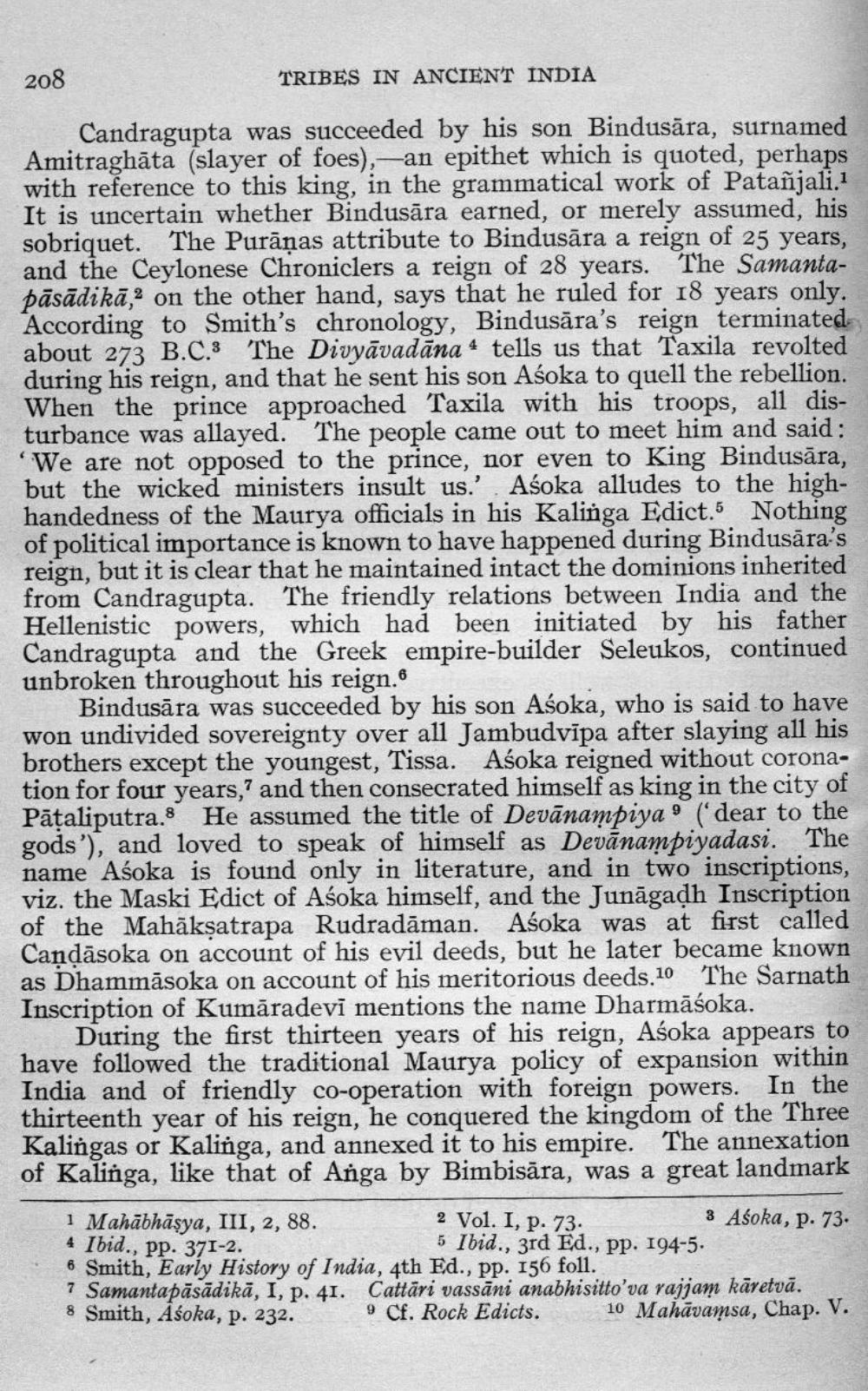________________
208
TRIBES IN ANCIENT INDIA
Candragupta was succeeded by his son Bindusāra, surnamed Amitraghāta (slayer of foes),--an epithet which is quoted, perhaps with reference to this king, in the grammatical work of Patañjali.1 It is uncertain whether Bindusāra earned, or merely assumed, his sobriquet. The Purāņas attribute to Bindusāra a reign of 25 years, and the Ceylonese Chroniclers a reign of 28 years. The Samantapāsādikā,2 on the other hand, says that he ruled for 18 years only. According to Smith's chronology, Bindusāra's reign terminated about 273 B.C.3 The Divyāvadāna 4 tells us that Taxila revolted during his reign, and that he sent his son Aśoka to quell the rebellion. When the prince approached Taxila with his troops, all disturbance was allayed. The people came out to meet him and said: 'We are not opposed to the prince, nor even to King Bindusāra, but the wicked ministers insult us.' Asoka alludes to the highhandedness of the Maurya officials in his Kalinga Edict. Nothing of political importance is known to have happened during Bindusāra's reign, but it is clear that he maintained intact the dominions inherited from Candragupta. The friendly relations between India and the Hellenistic powers, which had been initiated by his father Candragupta and the Greek empire-builder Seleukos, continued unbroken throughout his reign.6
Bindusāra was succeeded by his son Asoka, who is said to have won undivided sovereignty over all Jambudvīpa after slaying all his brothers except the youngest, Tissa. Asoka reigned without coronation for four years, and then consecrated himself as king in the city of Pāķaliputra. He assumed the title of Devānampiya' ('dear to the gods'), and loved to speak of himself as Devānampiyadasi. The name Asoka is found only in literature, and in two inscriptions, viz. the Maski Edict of Asoka himself, and the Junāgadh Inscription of the Mahāksatrapa Rudradāman. Asoka was at first called Candāsoka on account of his evil deeds, but he later became known as Dhammāsoka on account of his meritorious deeds.10 The Sarnath Inscription of Kumāradevi mentions the name Dharmāśoka.
During the first thirteen years of his reign, Asoka appears to have followed the traditional Maurya policy of expansion within India and of friendly co-operation with foreign powers. In the thirteenth year of his reign, he conquered the kingdom of the Three Kalingas or Kalinga, and annexed it to his empire. The annexation of Kalinga, like that of Anga by Bimbisāra, was a great landmark 1 Mahābhāsya, III, 2, 88.
2 Vol. I, p. 73.
8 Asoka, p. 73. 4 Ibid., pp. 371-2.
5 Ibid., 3rd Ed., pp. 194-5. 6 Smith, Early History of India, 4th Ed., pp. 156 foll. 7 Samantapāsādikā, 1, p. 41. Cattāri vassāni anabhisitto’va rajjam kāretvā. 8 Smith, Aśoka, p. 232.
9 Cf. Rock Edicts. 10 Mahāvamsa, Chap. V.




